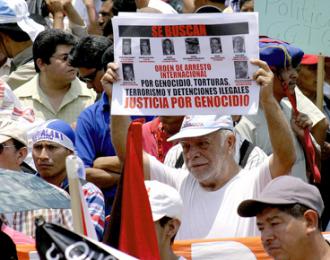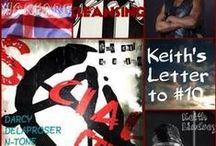But the history of U.S.-sponsored state violence against the Guatemalan people dates back much further--at least to 1954, when the CIA and the United Fruit Company overthrew President Jacobo Arbenz in a military coup. Since then, Guatemalans have faced one brutal government after another. A guerrilla war, inspired by the Cuban Revolution, began in 1960 and continued until the government and the guerrillas of the Revolutionary National Unity of Guatemala signed a UN-brokered peace agreement in 1996. Despite this, millions of Guatemalans--54 percent of the population--still live in dire poverty.
Over 60 years, Guatemalans formed many left-wing organizations to resist repression and exploitation. This history is heroic, but today's social movements remain fragmented. "Ernesto ," a left-wing activist who survived the repression and hopes to be a part of rebuilding a left-wing movement, talked to about this history.

Guatemalan protesters demand that Ríos Montt and other war criminals be brought to justice
WHAT WAS the colonization of Guatemala like?
THE SPANIARDS came to the "Americas" in 1492 and to Guatemala in
1497. For Guatemalans, it was a violent invasion. From the moment the
Spaniards invaded our land until today, they have destroyed Guatemala.
People are slaves in their own land. Our culture, religion--everything
changed. Catholicism became the official religion.They came looking for gold, but found something much more valuable: land. And in the name of God and the King of Spain, all the land was "theirs." The Spaniards didn't bring women at first. From the beginning, they violated and raped Mayan women.
Some estimates are that the Spaniards killed two-thirds of the Mayan Indians. Many were killed with guns, and others by diseases contracted from Spaniards or carried by rats aboard their ships. Let me be clear: What happened in Guatemala happened all over what is now called Latin America.
THE MAYANS are known for their beautiful traditional clothes. What's the story behind it?
IF YOU travel around Guatemala, you will see the Mayans wear
different clothes in different areas. The Spanish slave owners forced
them to do this so they could identify their slaves in different
communities. Later, with the same goal in mind, men were branded like
animals with permanent tattoos that were different in each town.
COULD YOU talk about the Guatemalan Revolution in 1944?
1944 BEGAN what we call "the 10 years of spring." The revolution by
students, workers and campesinos (poor farmers) overthrew the government
of President Jorge Ubico, who ruled from 1931 to 1944.From 1944 to 1951, Juan José Arévalo was the president. He set up a labor law with a fixed minimum salary for workers, vacations with pay for 20 days a year, pensions and the Social Security Institute of Guatemala. All workers, including campesinos, could use the state hospitals if you got sick. Workers didn't have to pay anything for health care. Education was obligatory and free for all kids.
Jacobo Arbenz was president from 1951 to 1954. He passed the first real agrarian land reform. He said, "Dear gringos (foreign companies), if you are operating here, you have to pay taxes." Foreign companies didn't pay anything to Guatemala.
He told the U.S. owners of the United Fruit Company (UFC) that they had to pay $10 million (U.S. dollars) in taxes for the 100,000 hectares they "owned." The UFC said no, they'd only pay $1 million. Arbenz kicked them out of Guatemala. Their lands became the heart of the agrarian reform. Their banana and coffee land was given to 10,000 poor Guatemalan families.
The U.S. got very angry and began a campaign against Arbenz. On April 13, 1954, at a meeting of the Organization of American States in Venezuela, the U.S. said they were going to invade Guatemala because they couldn't allow communism to take hold in Latin America. It was for the good of all Latin Americans for this to happen.
On June 21, 1954, the counterrevolution began. Based on a plan developed by Allen and John Foster Dulles, U.S. troops, using a base established in Honduras, invaded Guatemala. Arbenz fled. Carlos Castillo Armas took over as the president after the military coup.
WHAT MADE you decide to join the guerrillas?
AT ONE point, because of the repression, for a year and a half, I
lived on one of the university campuses in Guatemala. We slept and ate
there. The police were not allowed to enter the university property
according to national law. But every two hours, we took turns keeping
watch on the military base close by.One day, three military vehicles entered the university grounds. For arms, all we had was an old 38 mm pistol, a 9 mm and one rifle. However, we had fireworks. When the jeeps entered, we used the guns we had to shoot at them, and we set off the fireworks to make a lot of noise so it sounded like we had lots of weapons.
They turned around and left. I'm sure they would have killed us if we hadn't done this. There were only five of us there that night. At this time, I didn't think I'd be a part of the guerrillas. But this event made us think about society, the military, our role as students and what we can do to help people.
DID YOU have experiences as a guerrilla fighting in the mountains?
I WAS involved in three combats in the mountains. One of the times I
was fighting alongside my girlfriend when she was shot in the head. We
fought for another 20 minutes. She died next to me. It was one of the
saddest moments of my life, but there was hardly any time to cry. We
suffered a great deal during this time.
WHAT WAS the repression like before Efraín Rios Montt came to power? Could you give a few examples?
IN 1979 in Guatemala City, the military, after looking for one of the
movement leaders at his home and being unable to find him, they
kidnapped his three brothers. The bodies were found later naked in the
street, wrapped in barbed wire. Their penises were cut off and stuck in
their mouths.Another example was the murder of the director of San Carlos University in Quetzaltenango (Xela). One morning, two campesinos knocked on the door of his home. His wife answered and said he wasn't home. They asked when he'd be back. She said she didn't know.
They said they needed his help with some papers in order to get land. He was a lawyer who often helped campesinos. He was standing behind the door. He told his wife to let them in. He took them to his office. When they sat down to talk, they pulled out a gun and killed him.
These two examples--there are many more, of course--happened before Rios Montt came to power.
WHAT WAS it like living under Rios Montt?
RIOS MONTT was in power from 1982 to 1983. He implemented a plan
called the "Scorched Earth" with the aim of demolishing the land and
people. It had three main points.First, the elimination of the "subversion." The army wanted to "clean up" the north and west of the country, where the center of the guerrillas existed.
Second, setting up model towns. The military would take all the campesinos into one place. They had a strategic plan where the military surrounded the towns. They controlled the entrances to the towns. It was similar to a concentration camp.
Third, the creation of Civil Defense Patrols. Every member of these model towns was given a World War Two era gun in order to protect their family against communists. In each town an evangelical church was set up. Pat Robertson funded many of these churches in model towns. The cross and the military. The Spaniards, when they invaded, did the same with the Catholic Church. The U.S. did the same in the '80s with evangelicals.
The military held movie showings in the towns. In one of them, a female chicken lives happily with her baby chickens until a red wolf comes from behind the house. It captures and kills the chickens. After the military would explain the wolf was the communists who want to kill you. There was a great ideological campaign to control the indigenous people's minds.
Under his rule, the military said the Ixcan Triangle (encompassing the towns Nebaj, Cotzal and Chajul) was the most dangerous area for the military. They would hang comrades from their feet naked in front of the church, put gasoline on them, and set them on fire. How could soldiers do such horrible torture? They are like animals, worse than animals.
I still have cassette tapes of female campesinos from Chajul talking about the massacres they witnessed. A girl who was 14 at the time spoke about the military entering her house. The soldiers said you know where the guerrillas are. She said she didn't. She had a 2-month-old baby. The soldier grabbed the baby by his feet, said you are lying, and threw the baby against the wall, killing it instantly.
Rios Montt was behind all this. Otto Pérez Molina, now the president of Guatemala, was Montt's right-hand man. Molina was the military general in charge of destroying villages and murdering Indians. His nickname was Major Tito Arias. By some accounts 450,000 Guatemalans were murdered during the civil war, 1 million refugees fled to Mexico, and 440 villages were completely destroyed and wiped off the map.
HOW AND when did the civil war come to an end?
AFTER 36 years of civil war, on December 29, 1996, both sides--the
guerrillas and the military--signed a peace pact. I always said I was a
part of the guerrillas, but no one asked me what I thought. There was
never a vote about whether this pact was right or not. They didn't ask
their comrades what they thought. It was a decision by the leaders only.There were huge parties and celebrations because of the signing. Guerrillas turned in their guns. I didn't think it was time to sign the peace accord. Why? There weren't schools. People were hungry. And many of those guilty of crimes against the people were running free.
WHAT'S your life like now?
THE HOUSE I live in has walls of tin. They aren't proper walls. It's
open to the outside air. The floor is dirt, the earth. But it's my home.
After many years of fighting I have a little piece of land. I'm proud
of it. I'll give it to my kids in the future. Now I've been blacklisted.
I can't find a good job. Many doors were closed to me.I lost comrades, friends, girlfriends, kids, parents, and nothing changed. Former guerrillas are a part of the government. They are corrupt and not doing anything. There are former guerrillas who are now bodyguards for the rich.
I'm sentimental about the past. I cry about the past and present. The stupid government says, "Everything is OK. We've changed for good." It's hard to accept this reality. Why don't people rise up and fight? This is part of the real history of Guatemala.
http://socialistworker.org/2013/09/04/guatemalas-resistance-struggle

No comments:
Post a Comment